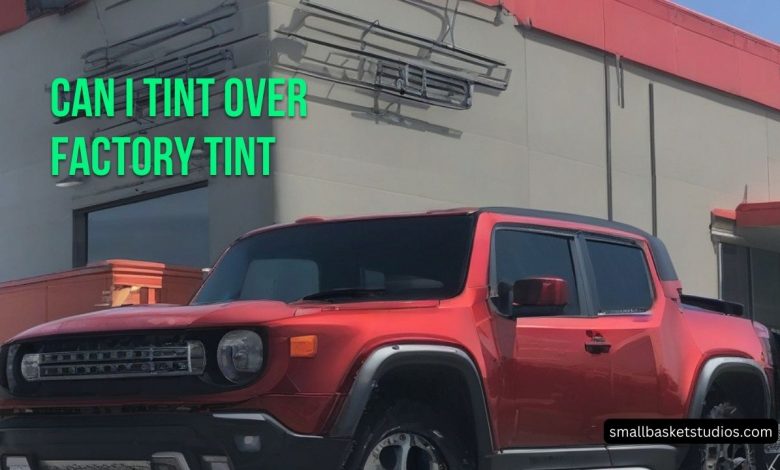Can I Tint Over Factory Tint? Exploring the Possibilities

Factory-tinted car windows help block glare and heat, but many drivers seek even darker tint for enhanced comfort, security, and style. This raises the question – can you apply additional auto window tint over the existing factory tint? The answer is yes, with some important caveats.
Extra tint layered over factory tint can further reduce interior glare and heat. It blocks more UV rays to protect skin and interiors. It also provides increased privacy and security due to darker windows all around the vehicle. However, issues like bubbling, hazing, adhesion failure or an illegal tint level can occur if the job isn’t done properly. Careful prep and high-quality dyed or ceramic aftermarket tint applied by a skilled technician provides the best results.
When researching adding extra tint, also investigate your state’s legal limits on tint darkness for the front driver/passenger windows compared to back seats and rear window. Fines, vehicle impounding and forced removal of overly-dark tint act as deterrents, though many still upgrade despite regulations. Determine if the risks outweigh the benefits for your needs and location before deciding whether to double up factory and aftermarket tints.
Can I Tint Over Factory Tint?
Can You Successfully Apply Tint Over Factory Tint? Yes, additional auto window tint can adhere successfully over factory tint under the right conditions. Key factors include:
- Proper cleaning and prep of the glass
- High-quality aftermarket tint
- Expert application by skilled window tint installer
- Allowing adequate drying and curing time
With attention to detail, extra darkening from double layers of tint provides the prime benefits drivers want without bubbling or purpling issues down the road.
Why Add More Window Tint?
Beyond style personalization, darker aftermarket tint over factory glass offers practical advantages:
Glare Reduction Lower internal glare improves visibility and decreases eye strain for safer, more comfortable driving.
Cooler Interior
Added tint blocks more infrared rays, keeping interior vehicle temperatures significantly lower on hot, sunny days. This saves on A/C costs as well.
UV Rays Protection
Extra blockage of harsh ultraviolet light helps protect skin from sun damage and prevents premature fading of interior furnishings.
Enhanced Privacy
Darker windows all around restrict outside visibility in for increased privacy and discreteness.
Added Security
With nearly opaque side and rear tint, smash-and-grab theft appears much more difficult, deterring criminals.
Customized Appearance
Deeper tints lend customized style not available with factory options, allowing drivers to achieve a signature look.
What Are the Risks?
Potential problems do exist when applying additional aftermarket tint over factory glass:
Adhesion Issues
Window tints adhere using pressure-sensitive adhesives. They bond tightly when correctly prepped and installed but can fail under the following conditions:
- Inadequate cleaning of factory glass
- Bubbles or debris trapped under
- Off-gassing interference between layers
- Insufficient curing time
Any loss of adhesion causes bubbling, staining, purpling or peeling, often within the first 1-2 years. Careful installation reduces this risk. Use high-performing tint backed by warranty coverage for defects.
Visibility & Safety Concerns
While deep tint provides relief from glare, overly dark windows also obstruct outward visibility, especially at night. This impairs safety for changing lane positions properly. Additionally, medical conditions like chronic headaches or anxiety in enclosed spaces may exacerbate from the cave-like environment of heavy tint all around.
Legality Issues
Most states regulate allowable visible light transmission (VLT) percentages permitted on the front driver and passenger windows. Adding tint over factory glass risks exceeding legal limits if improper combinations used. Fines, removal orders, and re-inspection costs quickly add up.
Which Type of Tint Works Best?
Advanced tech window films offer durability, transparency from both sides, and protection against heat/UV when paired as dyed films over factory tint. Ceramic nano-particle films take advantages even further.
Dyed Tint Films
Dyed tint uses metal-oxide particles suspended in the polyester layers to absorb and reflect light spectrum bands, reducing transmission to darken windows. High-grade dyed films resist damage from UV exposure and atmospheric contaminants much better than lower cost films. When layered, they block more light and add privacy.
Ceramic Nano Tint
The latest in window tint innovation, ceramic nano-particle films incorporate tin oxide ceramics in non-metallic form to reflect infrared heat. This further lowers interior temperatures while allowing clearer outward views. The ceramic layer also resists scratching and signal interference. Pairing ceramic tint over factor glass amplifies performance.
Adding Aftermarket Tint Over Factory Tint Step-By-Step
Follow these best practices from cleaning to curing when applying extra window tint over factory-tinted glass:
- Thoroughly Clean the Factory Glass Wash with isopropyl alcohol, using lint-free cloths across the full interior window area. This removes any residual oils, dust or grime so the new tint bonds tightly.
- Perform Adhesion Promotion Lightly abrade factory glass with a clean, fine-grit sanding pad, rubbing vertically only. This etches the surface very slightly to further improve adhesion. Fully wipe away debris after.
- Apply the New Tint Film Misting the window lightly before laying the film allows repositioning while preventing scratching the glass. From a middle edge outward, use a squeegee to press the tint firmly onto the factory glass.
- Trim Excess Tint Carefully run an razor along window edges to remove any overhanging tint material. Avoid nicking or gouging the car trim and seals.
- Allow Proper Curing Time
Leave new windows undisturbed, out of direct sun, as the tint adhesive fully sets up over 48-72 hours. Refrain from rolling windows up and down during this period. - Inspect for Problems
Small air pockets or bubbles may clear after a few days as tint finishes bonding. If not, or other issues appear like scratches, lift edges, staining or purpling, have them addressed under warranty.
Maintaining Dual-Layer Tint
Once professionally installed and fully cured, properly layered factory and aftermarket tint requires only basic ongoing care:
- Use microfiber cloths and specialized cleaners only
- Avoid spraying cleaner directly on windows
- Never use abrasive pads or bristle brushes on tint
- Wipe gently only using overlapping linear strokes
- Address minor lift edges quickly with re-burnishing
- Replace faded or damaged sections as needed
With attentive window prep, high-grade dyed or ceramic tint, expert installation, and proper curing time, additional aftermarket films over factory tint provide amplified benefits without adhesion loss or bubbling mishaps. Maintain as directed while avoiding window scratches and scrape damage against the tint. Dual-layer window films then deliver improved comfort, security and style for years of driving enjoyment.
Frequently Asked Questions About Adding Tint Over Factory Tint
Does extra tint help much if my car already has factory tint?
Yes. Adding 20-35% aftermarket tint over 15-25% factory glass provides noticeably increased glare reduction, cooling, and UV protection – nearly the same as applying darker tint to clear windows.
Can I apply 5% limo tint over factory glass?
Technically yes, but the 1-2% range total transmission risks excessively obstructed driver vision plus most states prohibit front windshield light passage below 70%. Consider 20% dyed or 30% ceramic for rear windows over factory tint instead for good darkness within legal limits.
How long does film over factory tint take to cure before rolling up windows?
Assuming proper installation, allow 3-5 days undisturbed curing time for aftermarket tint over factory glass, since it bonds in between two layers. Refrain from operating windows during this period while adhesives set completely.
Will added tint eventually bubble or peel off my factory glass?
Quality nano-ceramic films almost never delaminate when applied over thoroughly cleaned factory glass by a skilled professional installer. Low-grade dyed films carry higher risk but still perform reasonably well in most cases.
Can too much tint cause the factory glass to crack?
No. However inadequate edge trim coupled with repeatedly raising/lowering windows risks side edge glass cracks over time. Blunt force interior impacts also easily shatter heavily tinted windows. Always professionally replace chipped or struck glass.
Go Darker But Stay Legal: Responsibly Embrace the Benefits of Tint over Tint
Darker customized windows using aftermarket nano films over factory glass boost interior comfort and security without visibility loss – when responsibly selected for road safety and installed correctly to avoid adhesion failure. See clearly before taking vision further into deeply satisfying darkness.




